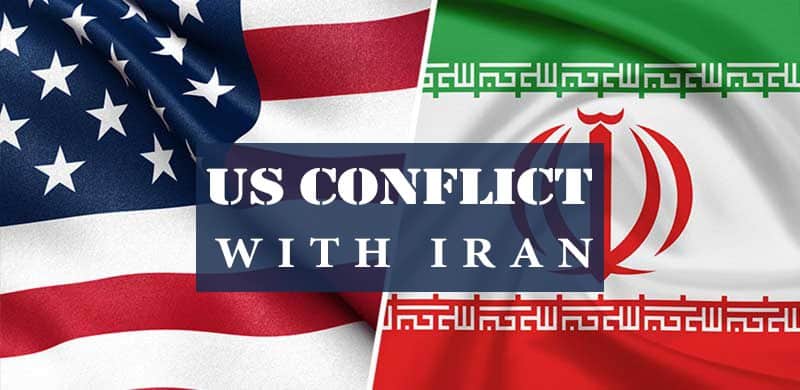The current issue of the day is the US conflict with Iran while all the European diplomats are scrambling to cool down this escalated tension.
Initial Relations Before US Conflict with Iran
The early association between the two countries, Iran and the United States, was subtle until the reign of the Shah, Naseeruddinshah. He then sent Mirza Abolhan Shirazi, the first Ambassador of Iran, to Washington, DC, in 1856. The U.S. was interested in Persian affairs, while the US was an outsider then. After World War I, the Persians again sought help from the U.S. to help with their finances.
Before World War 1, relations between the two countries were quite subtle. The outcome was that many Iranians condolenced the Constitutional revolutions of the Persians and saw America as an ally to free them from Russian and British domination over their affairs.
The U.S. embassy first participated in the 1921 coup in Britain at the Iran desk at the London Foreign Office, which escorted Reza Shah to showcase his potential. Reports from the British embassy 1932 acknowledge that the British put Reza Shah on the throne. At that time, the Iranians were clear that the United States was in an alliance with Britain.
Anglo-Soviet occupation of Iran in 1941 considered the former Shah an axial inclination and formed the supply route to the USSR. Since 1942, American armed forces operated the Persians passage, one of which supplied to the U.N. USSR. The former Shah, Muhammad Raza Pahlavi, continued close bonds with the United States for most of his time. The Islamic Revolution overthrew the regime from 1941 to 1979.
Prime Minister Mossadeq
In 1952 and 1953, the calamity of the Abadans occurred when the Prime Minister of Iran, Mohammad Mossadeq, began nationalizing the Anglo-Iranian Oil Company (AIOC). That firm divided the profit by 85% to Britain and 15% to Iranians, but the cooperation would withdraw its economic documentary from the government of Iran.
The British banned oil from Iran, which got assistance from international oil firms. As the months passed, discussions over the jurisdiction and oil payment ceased, and Iran’s financial system worsened.
1979 Revolution
It shocked the U.S. executives during the period, which overthrew Shah (who supported Americans and transferred with the U.S. supreme leader Ayatollah Khomeini). Islamic rebellions wanted to hand over the evicted Shah so that they could get him impaled.
Shah, suffering from cancer, sought entry in the U.S. for recovery. At first, Americans protested, but President Carter agreed to let him go to Iran. They suspected that the Shah was actually against the Iranian revolution; thus, they claimed that the former emperor was an American puppet.
Mortgage Crisis
52 U.S. executives were taken for 444 days. Iranians were afraid that the United States might launch another coup against them from the United States ministry in 1979. The U.S. Army started the “Operation Eagle Claw” Act on April 26, 1980, which ended as an aborted mission in 1981. Later, a treaty was signed to free the hostages.
On seven April 1980, Carter cut diplomatic relations between the Asian nations and, therefore, the U.S., and they have since been frozen. Since twenty-one May 1980, the European country has been a militia for the U.S. in Asia. The Asian nation pictured interests within the United States once the Algerian Embassy showed him. However, Iran later selected Pakistan as its defense power within the U.S.
1988 U.S. Attack
In 1988, the U.S. launched Operation Praying Mantis against an Asian country, claiming that it had been retaliation for the Iranian mining of the Gulf region. The American campaign began with coordinated attacks on the ground. Iran lost an oversized combat ship and a tiny low firing. Asian country sued for reconsideration within the International Court of Justice, stating that the U.S. dissolved in 1955
Axial State of Immorality and US Conflict
In the era of President Bush, he lectured Persia, Asian nations, and North Korea as the Axis of Evil. These countries were developing long-range missiles, and this constituted terrorism for the United States. The speech sparked fury among Iranians and was denounced by Republicans.
Later, in 2003, the U.S. area unit launched aerial vehicles from the Asian nation to the Islamic Republic of Persia to get secrets regarding the Iran nuclear program, therefore providing data regarding it. The U.S.A. is known as a watchdog that was an additional dominated contraband by the Iranians.
Start Infiltration at the Border
Us has been violating Iran’s territorial jurisdiction since 2003, together with troopers, drones, and also the Party for Free Life in Kurdistan. Seymour claimed that the United States is trying to infiltrate eastern Iran from Afghanistan’s border in a hunt to establish the development of nuclear weapons. US conflict with Iran is escalating with the use of drones.
Drone Strikes
The most recent drone incident occurred on June 20, 2019, with the Iranian military destroying an American drone. Which caused more problems and tensions between the two countries in the Middle East. U.S. officers confirmed that the drone was on a police work mission. It affected Iran’s guided missile in international airspace, which was shot down, later causing more conflicts.
Consequences of US conflict with Iran
To date, both countries have opened fire. So the conflict between them continues in the shadow where it has been fought for 40 years.
But after the assassination of Qasim Solimani, Iran now knows that any attack on its Paroxysm launch could lead to a U.S. attack. Donald Trump expressed satisfaction that Tehran has learned its lesson, saying it is “ready to embrace peace with all.”
All of this leads to an epic war that would involve nuclear weapons and, thus, mass destruction in the world. There is news that it will be “World War 3”. we are all aware of the consequences of wars in history. The last time unified outrage against the U.S. helped consolidate the 1979 revolution.
Other nations are reluctant to cooperate with the U.S. The US conflict with Iran and illegal killings made the U.S. allies unwilling to back Trump in further confrontations.


